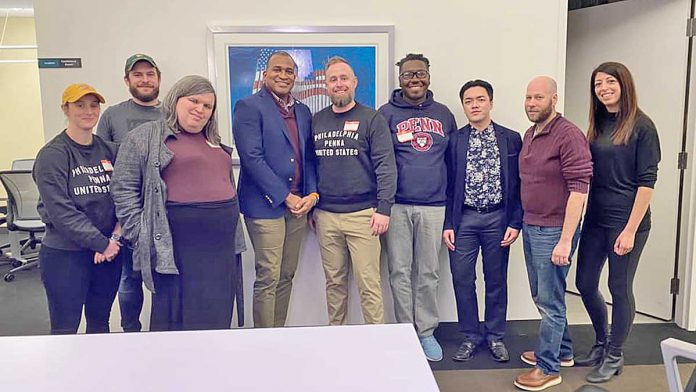As part of a live stream series on the new coronavirus, Liberty City LGBTQ Democratic Club hosted the virtual session “The Racial Divide of COVID-19” last week, facilitated by out Liberty City board member Tariem Burroughs and featuring Dr. David O’Gurek, family physician at Temple University Hospital and assistant professor of family and community medicine in the Center for Urban Bioethics in the Lewis Katz School of Medicine.
“In the past few weeks, this pandemic has pointed out glaring differences of inequality of health and the relationships of Black and Brown people with the healthcare system, from [Rev.] Al Sharpton’s interview with Dr. Fauci, Trevor Noah’s in-depth exposé and the daily news stories about the increase in positive diagnosis and sadly deaths in Black and Brown communities due to this virus,” Burroughs told the audience before he introduced O’Gurek.
In the City of Philadelphia’s April 9 press briefing, Health Commissioner Tom Farley reported that of the then-104 people who died of the coronavirus in Philadelphia, 38% were African American, compared to 24% of white people. “This does suggest that there’s higher rates of mortality of this infection in African Americans than the general population,” Farley said. “This does worry us that like many other health problems, this problem is affecting people who have disadvantages even more.”
Social determinants of health, O’Gurek explained, are the non-medical aspects of a person’s life that play a role in their overall health, including “access to transportation, education, housing, literacy levels, opportunities for a clean environment, access to playgrounds.”
Fielding a question from Burroughs, O’Gurek discussed the multifaceted nature of the dissemination of information, including TV and print journalism, social media, daily press briefings from the City of Philadelphia’s Department of Public Health and healthcare institutions themselves.
O’Gurek explained that many members of the Black and Brown community get information from community benefit organizations, often questioning information coming from government and healthcare organizations.
“There’s inherent mistrust, particularly within the Black and Brown community, to those particular institutions for historical and ongoing reasons,” O’Gurek told the audience. “Certain information that you’re getting in the news media, particularly on television, certainly hasn’t been up to date, hasn’t been scientific and is often anecdotal evidence, particularly from some of our political leaders.”
Another issue that Burroughs raised had to do with hotspots of the coronavirus, or areas containing a particularly high number of people who are infected, pointing to Southwest Philadelphia and the area surrounding Temple University, both home to many people of color.
“The media draws all this attention as if [these hotspots are] a new thing, or as if these health inequities are surprising,” O’Gurek told the audience. O’Gurek cited the chronic diseases that occur more frequently in Black and Brown communities, including diabetes and asthma, as potential reasons for the existence of these hotspots. However, he said the root of the problem is what’s necessary to understand.
“Race-based medicine where the structural racism that has traditionally affected all different sectors and all different communities, has invaded medicine from this respect,” O’Gurek told the audience. “Where we’ve taken a social construct [such] as race, and substituted it as ‘oh yeah, clearly that population is more likely to develop those chronic diseases.’ When we look at the literature and the data, that’s not true.”
Fielding audience questions, O’Gurek talked about the availability of testing sites for Black and Brown people and flattening the curve.
“The availability of testing sites like you perhaps have seen on the news … or the testing sites that were happening in the opposite end of the city down by the stadiums…. [which] were just available [as] walk-up or drive-up testing, weren’t available in the communities around us,” O’Gurek said. “It was a conversation that Temple had at the very beginning because many of the testing sites that were being developed were drive-up testing sites. A large percentage of our population … rely on public transportation, and don’t have the ability to go to a drive-up testing center.”
O’Gurek explained that some of the Philadelphia neighborhoods in which there are higher instances of the coronavirus diagnoses are what he called “primary care deserts,” or areas that lack primary care centers that provide basic healthcare services.
“There are areas in the city of Philadelphia, in West Philly, Southwest Philly and North Philly, that have very limited access to primary care services … so then getting testing was complicated.”
O’Gurek said that part of the key to flattening the curve in communities of color lies with establishing dialogue between government and healthcare workers and people of color. “When we talk about these inequities and challenges, we need to make a true commitment and… actually address the past,” he told the audience.
“As the people who are doing a lot of the action and a lot of the activity, from the government, from healthcare, we have a lot of work to do to rebuild trust within communities. We need to be honest and have conversations. We individualize healthcare; let’s be person-centered and patient-centered and community-centered with what we do with some of these public health practices as well.”
Liberty City holds live stream sessions about the new coronavirus on its Facebook page Wednesdays at 6 p.m. https://www.facebook.com/LibertyCityDems/
